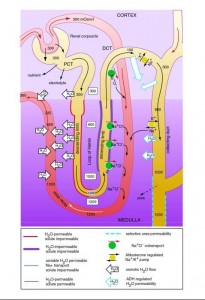I. The Mammalian Kidney
A. Overall function – homeostasis
Controls composition & volume of blood, excretes waste, helps to regulate blood pressure, erythropoiesis, and activate vitamin D
B. Significant structures
1. Cortex
Outer area
2. Medulla
Inner area
Comprised of renal pyramids [8-18]
3. Renal pelvis
Area collecting urine and emptying it into ureter
4. Microstructure
a. Nephron– functional unit of kidney
1. Glomerulus
Network of permeable blood capillaries that are fenestrated
a. Cortex
b. Afferent & efferent arterioles
c. Slits; Pores
2. Renal tubules
a. Glomerular capsule (Bowman’s) [cortex]
– Renal corpuscle = glomerulus plus glomerular capsule
b. Proximal convoluted tubule [cortex]
c. Descending limb of loop of nephron (Henle)
d. Loop of nephron
e. Ascending limp of loop of nephron
f. Distal convoluted tubule [cortex]
g. Collecting tubule
C. Nephron physiology
1. Glomerular filtration [45 gal./day of filtrate, but you urinate 2-4 pts/day ]
a. Definition
Passive process, materials move out of glomerulus into capsule
b. Net filtration pressure:
Filtration Pressure = Glomerular blood pressure – [Capsular pressure + Colloid osmotic pressure]
1. Glomerular blood pressure in kidney capillaries [60 mmHg is the approximate glomerular blood pressure which is nearly double that of a regular blood capillary] this favors filtration
2. Capsular pressure This is the pressure in the Glomerular Capsule that is receiving whatever is filtered out of the blood. It is the push of fluids from the capsule, opposes filtration
3. Colloid osmotic pressure This is the substances (such as albumin proteins) in the blood that tend to draw fluids back into the glomerular capillaries. It is primarily unfiltered plasma proteins that oppose filtration
2. Tubular Reabsorption & Secretion
a. Proximal Convoluted Tubule
1. Permeable to solutes and they are reabsorbed from kidney tubules to the bloodstream. (glucose, amino acids, organic molecules, Na, Ca, Cl, Vitamins);
2. They are nearly all reabsorbed (active)
3. Permeable to water; it’s reabsorbed
(passive), 65% decrease in volume
4. Tubular secretion [H+, K+]
b. Descending limb of loop of nephron
1. Relatively impermeable to solutes
2. Permeable to water, it’s reabsorbed
3. Interstitial gradient promotes water reabsorption
c. Loop of nephron (permeable to urea)Urea is recycled
d. Ascending limb of loop of nephron
1. Permeable to NaCl; it’s reabsorbed
2. Impermeable to water
e. Distal convoluted tubule
1. Aldosterone & ADH (anti-diuretic hormone)
2. Secretion (H+, NH3, drugs)
3. Juxtaglomerular apparatus (renin & Erythropoietin precursor)
f. Collecting tubule/ducts
1. Aldosterone causes sodium reabsorption
2. ADH causes water reabsorption
3. Urea
3. Vasa recta
Countercurrent thin walled blood vessels serving tubules
a. Maintains interstitial concentrations
b. Aids in concentrating urine
c. Absorbs some H2O
The figure below explains all of the notes above on kidney physiology. Study it thoroughly.

